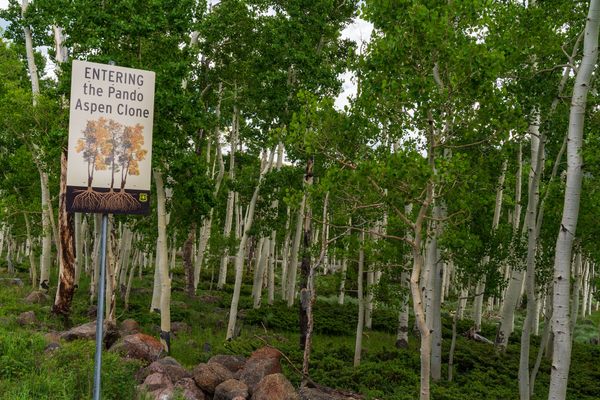Strip-Mall Totems: The Trees of Sprawl
McDonald’s and Douglas-firs (photograph by Sarah West)
The form or look of the tree arises from annually repeated patterns of branching, elongation, thickening, and death.
— Brayton F. Wilson, The Growing Tree
While it’s easy enough to take the virtues of street and park trees for granted — the shade they cast, the vaulted tunnels and cathedrals they form—those giants are, generally, beloved. Not so the trees of the American sprawl-spaces: strip malls and unfinished subdivisions and warehouse outskirts and truck cities. You can go years without truly seeing them, and yet there they are: The prim Boxelders on the little curbed islands in the Home Depot parking lot. The flank of twisted Shore Pines along the freeway onramp. The toppled Sweetgum branch pinning an Arby’s bag on the median grass of the bus stop.
These forgotten or overlooked trees engage with us on multiple levels, whether we notice or not; they’re full of stories. Many, obviously, were planted — planted to soften a massive hardscape, arrest fresh-bared soil, comply with municipal regulations. A few might be legacy trees from pre-sprawl farmland or prairie copses. Others colonize the sprawl-scape via a bird’s gut or a propitious breeze.
Many we call “exotics,” coming of evolutionary age in some faraway place and planted here deliberately for their beauty or utility, or sprung up as opportunistic feral invaders. “Native” trees in sprawl-space landscaping, though, have particular power, harmonizing with wild fellows in the city hinterland. Winter storms in the Pacific Northwest set shopping mall Douglas-firs swaying in remote concert with free-growing ones in the backdrop foothills. Royal Palms squaring off Miami gas stations call to mind those lording in a magnificent supercanopy over jungle hammocks a few dozen miles away. These biological kinships give some sense of continuity to sprawl, otherwise so unapologetically out-of-place.
However manicured they are, sprawl-scape trees always seem a bit lonesome — reflecting, I guess, the inherent lonesomeness of their surroundings. Lonely is the shadow the Red Maple casts all night in the glare of a warehouse security light, the same glow that fools the tree into delayed displays of autumn foliage. Heavy spring rain lingers on the row of Scots Pines at the rest stop, their needle sprays glistening and dancing against the chrome bloodstream of the interstate. The Cabbage Palm edging the McDonald’s drive-thru has tarnished fans and rugged bootjacks daily blasted with exhaust.
Palm trees at a Florida strip mall (photograph by Daniel Oines/Flickr)
Windmill Palm at the strip mall (photograph by Ethan Shaw)
Tree in a Houston parking lot (photograph by HF5523/Wikimedia)
Like a falcon nailing a pigeon over Denny’s or a brushfire erupting in the brambles by the railroad tracks, these sprawl-scape trees remind us that even the most abused and disparaged plot of land is, nonetheless, a real, honest-to-goodness ecosystem. That small Hawthorn in the Walmart parking lot is busily pulling moisture from the sky and phosphorus from the soil, still offering its rough bark for the perches of lichen and the murderous booby-traps of spiders. Marooned amid dollar stores and car washes, a grove of firs still drips with fog, swallows wind, and becomes a grand nighttime roost for winter crows.
Because a strip mall doesn’t inspire the same kind of reverence as a snow-clad mountain range or giant waterfall, we forget it’s as much a part of the planetary framework as anywhere else. Yes, it’s a ravaged piece of countryside, with mostly impervious surfaces and oil puddles and monstrously consumptive appliances. But the ground it occupies is still the skin of the Earth: bedrock that has done its time under the sea or in a volcano’s throat; sediment that’s been washed in by floodwaters or shed off a glacial snout. As the Romans would say, there’s still a “genius” of this spot, an authentic revelation of the world’s vital energy.
New friends and dear sweet old tree ghosts
here we are again. Enjoy the day.
— Gary Snyder, Danger on Peaks (from “Enjoy the Day”)
The soul of a place is unlikely to express itself in commercial or industrial infrastructure that’s been carbon-copied all over the country. By contrast, a tree — in decades-long conversation with the site’s soil, sunlight, wind, moisture, and animals — manifests the essential spirit of the landscape. Its ultimate form stems not only from a genetic blueprint, but also the special conditions and events of its location, and thereby encodes history and longterm pattern.
The sprawl-scape tree bridges deep time and the neurotic pace of modern development and redevelopment. Tapping soil built over millennia, it endures overzealous pruning to accommodate power lines, roots severed by roadwork, and the scorch of spun-up road salt. Its canopy memorizes the geography of airflow through the canyons of the big-box stores. Its lopsided figure has duly logged the ice storm of forty years ago.
Trees buck against the ugliest hallmarks of sprawl. In these homogenized, willfully out-of-context realms, they’re biological totems. They summon at once the landscapes and eras of their evolutionary heritage and the here-and-now wastes they presently inhabit. They sing to our blood, forged as it was in long-ago forests and then savannas. They look good at sunset and heaving in a gale. And through them we may pay a little respect to a piece of turf we’ve otherwise pillaged, remembering that the Earth itself never dies.
Autumn in a Portland parking lot (photograph by Fabio Mascarenhas/Flickr)
Twisted sumacs in an urban median (photograph by Sarah West)

























Follow us on Twitter to get the latest on the world's hidden wonders.
Like us on Facebook to get the latest on the world's hidden wonders.
Follow us on Twitter Like us on Facebook